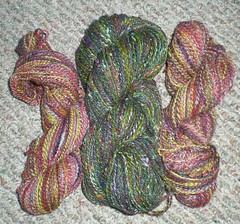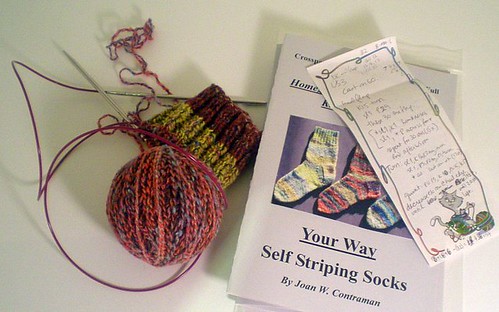 Recently on Ravelry, there have been some threads on what makes handspun yarn bloom. That is to say, once you have your yarn all spun up and plied, and you skein it up and wash it, it poofs up quite a bit -- the unfinished fingering weight handspun turns into DK or worsted weight once it's finished. Like the yellow & red skeins here.
Recently on Ravelry, there have been some threads on what makes handspun yarn bloom. That is to say, once you have your yarn all spun up and plied, and you skein it up and wash it, it poofs up quite a bit -- the unfinished fingering weight handspun turns into DK or worsted weight once it's finished. Like the yellow & red skeins here.Unfinished, they were 16 wpi, perfect for socks ... finished, well, gulp, they bloomed their way up to 12 wpi. From sportweight to worsted ... what to do? More on that, at the end.
There are a few factors that can affect the amount of bloom in yarn:
- crimp in the fibers -- the tighter the crimp is, the more little springs there are in your yarn elbowing their way around to poof it out, given the opportunity. A warm soak is an excellent environment for the crimp to activate its abilities.
- spinning style -- woolen spinning allows air into the yarn, so when it's taken off the bobbin and skeined up, there's more room for air to move around in the yarn, a poofier yarn results than the yarn wound on the bobbin. Worsted spinning involves squeezing the daylights out of the fibers as you spin them and keeping them all aligned along the length of the yarn as well -- minimum opportunity for air. You guessed it -- air room gives the crimp room to spring into action (oooh, bad pun!)
- fiber preparation -- carded preparations are more random and allow more air for fiber to bloom, while combed preparations are more parallel and compact. This is also why we spin woolen style with carded fibers and worsted with combed -- the spinning method enhances the features of the fiber preparation. Sure, you can spin combed top woolen, it just won't be as poofy as the same fiber, carded and spun woolen.
- amount of twist -- high twist yarn leaves less room for blooming, lower twist yarns leave more. That said, a balanced plied yarn has the fibers parallel to the length, so they can crimp up if there's room, while a single or an unbalanced plied yarn has excess twist trapping the crimp in the fibers.
- finishing style -- if you do a quick washing soak and rinse, squeeze out the water, and hang the skein to dry with weights, you are giving it minimal opportunity to activate its springiness. Especially drying it with weights -- weavers do this, because the warp needs to be under tension on the loom; but knitters typically don't dry with weights, because springiness is desirable in knitting yarn. If, on the other hand, you put it in the wash bath, let it soak a few minutes, then put your hands in the bath and squish the skein a bit, you are helping it bloom. Do the same in the rinse bath, squish it again -- bloom-age. Once you've taken it out and squeezed out the water, snap it around your wrists a few times or better, whack it a few times on the counter top -- that not only helps even out the plying twist a little, it ... you guessed it ... helps it bloom :-) then, hang it to dry without weights.
For more on this see the Ravelry postings by jamie12 in Spin Tech and a thread started by DDeMarie in spinning knitters
All that said, remember, every fleece even within a breed, can differ -- and in commercial fibers, even with the mix of fleeces they contain, different runs will differ too. Wool, alpaca, cashmere and others -- look at the individual fibers within your preparation to see what crimp it shows.
When I want yarn to bloom, what I look for first is a high-crimp fiber, like Cormo, California Variegated Mutant, or Targhee. Then, I spin woolen, for a balanced 2-ply with about a 25 degree angle of twist (moderate twist), and usually I spin to match the crimp, with a goal of the 2-ply's wraps per inch equalling twice the crimps per inch.
It's worth noting that most commercially prepared top has been ironed or steamed flat. Re-wetting it in a warm bath can help awaken its twist before you spin it, if your goal is maximum bloom. This is why, if you dye commercially prepared top, it often goes crinkly/wavy like a permanent wave -- the dye process adds water and heat to the fiber, awakening its crimp. Once the crimp is awake, technically, it's no longer the prepared fiber you started with -- and effectively, you'll get a slightly different yarn from spinning it.
And what am I doing with my worsted weight sock yarn? Adjusting the pattern of course ... maybe once this pair of warm winter socks is done, I'll spin up another tube (finer!) to knit a pattern to spec.

This is the new pattern from Joan Contraman, Your Way: Self Striping Socks. The spinning instructions for making the stripes were marvelous, and the knitting is fun too ... I want to keep going to see which color shows up next!
~~~~
Related posts:
How thickly should I spin a given breed of wool? Cormo? Romney?
How can I spin fluffy yarn?
How can I spin fine yarn?
How do I know what sheep breed to look for?
How do you make a good looking 2-ply yarn?
Is my yarn's twist set when I ply it?
Why do you wash the finished skein in warm or hot water?
~~~
We're snowed in here with more expected tonight ... many of my internet friends report the same. Keep warm out there! And those of you in warmer climes -- fan a little of that warm air this way, please.
